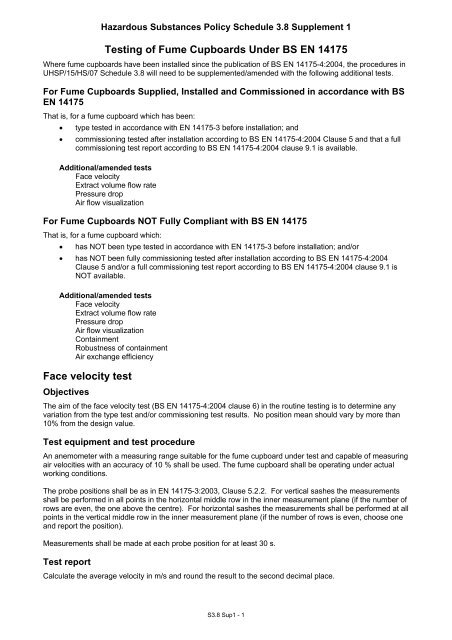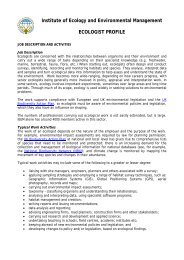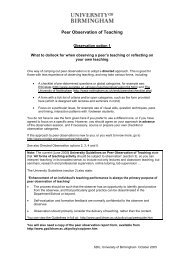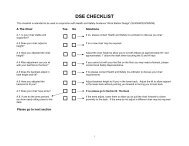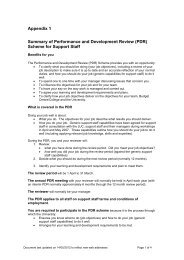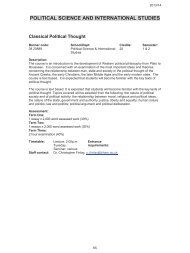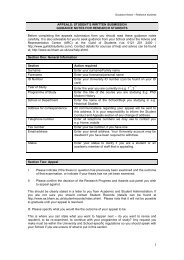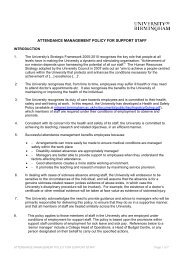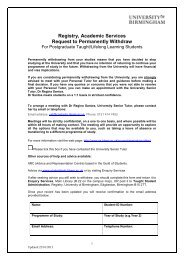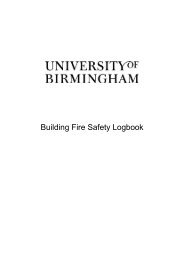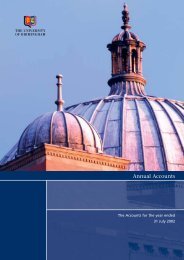Additional test for fume cupboards under BS EN 14175 (PDF 67KB)
Additional test for fume cupboards under BS EN 14175 (PDF 67KB)
Additional test for fume cupboards under BS EN 14175 (PDF 67KB)
Create successful ePaper yourself
Turn your PDF publications into a flip-book with our unique Google optimized e-Paper software.
Hazardous Substances Policy Schedule 3.8 Supplement 1Testing of Fume Cupboards Under <strong>BS</strong> <strong>EN</strong> <strong>14175</strong>Where <strong>fume</strong> <strong>cupboards</strong> have been installed since the publication of <strong>BS</strong> <strong>EN</strong> <strong>14175</strong>-4:2004, the procedures inUHSP/15/HS/07 Schedule 3.8 will need to be supplemented/amended with the following additional <strong>test</strong>s.For Fume Cupboards Supplied, Installed and Commissioned in accordance with <strong>BS</strong><strong>EN</strong> <strong>14175</strong>That is, <strong>for</strong> a <strong>fume</strong> cupboard which has been:• type <strong>test</strong>ed in accordance with <strong>EN</strong> <strong>14175</strong>-3 be<strong>for</strong>e installation; and• commissioning <strong>test</strong>ed after installation according to <strong>BS</strong> <strong>EN</strong> <strong>14175</strong>-4:2004 Clause 5 and that a fullcommissioning <strong>test</strong> report according to <strong>BS</strong> <strong>EN</strong> <strong>14175</strong>-4:2004 clause 9.1 is available.<strong>Additional</strong>/amended <strong>test</strong>sFace velocityExtract volume flow ratePressure dropAir flow visualizationFor Fume Cupboards NOT Fully Compliant with <strong>BS</strong> <strong>EN</strong> <strong>14175</strong>That is, <strong>for</strong> a <strong>fume</strong> cupboard which:• has NOT been type <strong>test</strong>ed in accordance with <strong>EN</strong> <strong>14175</strong>-3 be<strong>for</strong>e installation; and/or• has NOT been fully commissioning <strong>test</strong>ed after installation according to <strong>BS</strong> <strong>EN</strong> <strong>14175</strong>-4:2004Clause 5 and/or a full commissioning <strong>test</strong> report according to <strong>BS</strong> <strong>EN</strong> <strong>14175</strong>-4:2004 clause 9.1 isNOT available.<strong>Additional</strong>/amended <strong>test</strong>sFace velocityExtract volume flow ratePressure dropAir flow visualizationContainmentRobustness of containmentAir exchange efficiencyFace velocity <strong>test</strong>ObjectivesThe aim of the face velocity <strong>test</strong> (<strong>BS</strong> <strong>EN</strong> <strong>14175</strong>-4:2004 clause 6) in the routine <strong>test</strong>ing is to determine anyvariation from the type <strong>test</strong> and/or commissioning <strong>test</strong> results. No position mean should vary by more than10% from the design value.Test equipment and <strong>test</strong> procedureAn anemometer with a measuring range suitable <strong>for</strong> the <strong>fume</strong> cupboard <strong>under</strong> <strong>test</strong> and capable of measuringair velocities with an accuracy of 10 % shall be used. The <strong>fume</strong> cupboard shall be operating <strong>under</strong> actualworking conditions.The probe positions shall be as in <strong>EN</strong> <strong>14175</strong>-3:2003, Clause 5.2.2. For vertical sashes the measurementsshall be per<strong>for</strong>med in all points in the horizontal middle row in the inner measurement plane (if the number ofrows are even, the one above the centre). For horizontal sashes the measurements shall be per<strong>for</strong>med at allpoints in the vertical middle row in the inner measurement plane (if the number of rows is even, choose oneand report the position).Measurements shall be made at each probe position <strong>for</strong> at least 30 s.Test reportCalculate the average velocity in m/s and round the result to the second decimal place.S3.8 Sup1 - 1
Hazardous Substances Policy Schedule 3.8 Supplement 1Extract volume flow rate <strong>test</strong>ObjectivesThe aim of the extract volume flow rate <strong>test</strong> (<strong>BS</strong> <strong>EN</strong> <strong>14175</strong>-4:2004 Clause 5.5) as part of the routine <strong>test</strong> is toverify whether the extract volume flow rate is maintained compared with the commissioning value, using oneof the methods described. The sealing of the <strong>fume</strong> cupboard's leakages (see Clause 5.5.2.2) is notnecessary, provided a correlation factor <strong>for</strong> the sealed and non-sealed face velocity has been established <strong>for</strong>the methods and conditions used.The extract volume flow discharged from a <strong>fume</strong> cupboard can generally be measured according to ISO5221. When the requirements <strong>for</strong> the use of this method are not fulfilled, one of the following methods canbe applied.Average face velocity method <strong>for</strong> Extract volume flow ratePrinciple, <strong>test</strong> equipment and probe positionsThis method determines the extract volume flow by measuring the face volume flow in the sash opening bymaking sure that all the extract air is flowing through the sash opening. Test equipment and probe positionsin accordance with <strong>EN</strong> <strong>14175</strong>-3:2003, 5.2.1 and 5.2.2.PreparationAny significant leakage, slit or opening of the <strong>fume</strong> cupboard, except of the <strong>test</strong> sash opening, shall besealed by adhesive tape or appropriate air tight material. The sealing material shall be removed after theface velocity measurement. The <strong>test</strong> shall be carried out with the <strong>fume</strong> cupboard's sash(es) set at one of thetype <strong>test</strong> sash opening(s) (see <strong>EN</strong> <strong>14175</strong>-3:2003, 4.4.2).Test procedure and <strong>test</strong> resultsAccording to <strong>EN</strong> <strong>14175</strong>-3:2003, 5.2.3 and 5.2.4.Expression of resultsMultiply the average face velocity at the sash opening with the area of the sash opening and report theresulting volume flow rate in m3/h together with the average face velocity, the sash area and the chosensash opening. If the face velocity <strong>test</strong> according to 5.4 has been per<strong>for</strong>med, a correlation factor <strong>for</strong> the facevelocity of the sealed and non-sealed <strong>fume</strong> cupboard can be calculated and documented in thecommissioning <strong>test</strong> report as reference value <strong>for</strong> subsequent routine <strong>test</strong>ing (see 6.3).Calibrated pressure difference method <strong>for</strong> Extract volume flow ratePrinciple and <strong>test</strong> equipmentThis method depends on the availability of manufacturer specified reference points. The method determinesthe extract volume flow by measuring the pressure difference between two reference points specified by the<strong>fume</strong> cupboard's manufacturer. Test equipment in accordance with <strong>EN</strong> <strong>14175</strong>-3:2003, 5.6.2.Positioning of pressure tap(s) and <strong>test</strong> procedureThe <strong>test</strong> shall be carried out with the <strong>fume</strong> cupboard's sash(es) set at one of the type <strong>test</strong> sash opening(s)(see <strong>EN</strong> <strong>14175</strong>-3:2003, 4.4.2). The pressure tap(s) shall be fitted to the reference point(s) specified andmarked by the <strong>fume</strong> cupboard's manufacturer. Test procedure according to <strong>EN</strong> <strong>14175</strong>-3:2003, 5.6.5.Expression of resultsTake the extract volume flow corresponding to the measured pressure difference from the table or diagramsupplied in the manufacturer's documentation. Report the measured pressure difference and the evaluatedextract volume flow in m3/h together with the manufacturer's documentation identification and the referencemeasuring point(s).Sequential average face velocity <strong>test</strong> <strong>for</strong> Extract volume flow ratePrinciple, <strong>test</strong> equipment and probe positionsS3.8 Sup1 - 2
Hazardous Substances Policy Schedule 3.8 Supplement 1This method determines the extract volume flow rate by measuring the face velocity in the sash opening of a<strong>fume</strong> cupboard using an anemometer. The anemometer shall be of an integrating type and shall be capableof measuring unidirectional air velocities down to 0.3 m/s or better. The accuracy of an individual readingshall be better than 0.02 m/s + 5 % of the reading. The anemometer should also be able to calculate theresults in terms of air volume flow rates.Test procedure and <strong>test</strong> resultsThe <strong>test</strong> should be carried out with the <strong>fume</strong> cupboard’s sash set to a sash opening of 100 mm.The <strong>test</strong> is to be carried out within the resulting area of opening. The anemometer shall be continuouslyoriented so that the velocity component perpendicular to the plane of opening is measured. Move theanemometer using a constant speed to scan the length of the opening. The time <strong>for</strong> scanning andintegrating should be 60 s.Test reportNote the measurement value in metres per second. Multiply the average face velocity at the opening planewith the area of the opening plane and report the resulting volume flow rate in cubic meter per hour togetherwith the average face velocity and the opening plane’s area.Pressure drop <strong>test</strong>To be per<strong>for</strong>med according to <strong>BS</strong> <strong>EN</strong> <strong>14175</strong>-4:2004 Clause 5.6. The cause of any variation from thecommissioning value should be investigatedAir flow visualizationTo be per<strong>for</strong>med according to <strong>BS</strong> <strong>EN</strong> <strong>14175</strong>-4:2004 Clause 5.7. The aim of the air flow visualisation is toobtain qualitative in<strong>for</strong>mation regarding present room air flow and the interaction of the <strong>fume</strong> cupboard's airflow with the room air flow. Based on the <strong>test</strong> result, it should be decided whether the following room airvelocity <strong>test</strong> is necessary.Test procedureAir flows around the installed <strong>fume</strong> cupboard and in the sash opening area should be visualized to check ifthere are any disturbances, e. g. by the room make-up air, that could affect the per<strong>for</strong>mance of the <strong>fume</strong>cupboard. Visualization shall be per<strong>for</strong>med with generation of visible tracers, such as smoke, about 400 mmin front of the <strong>fume</strong> cupboard with release upwards to the ceiling. The density of the tracer shall be close tothe room air density. The tracer shall be distributed with low impulse and not faster than 0.2 m/s.Expression of resultsAir movements around the working aperture shall be visualized and if there is any kind of disturbance it shallbe documented and the following <strong>test</strong> per<strong>for</strong>med.Room air velocity <strong>test</strong>ObjectivesThe aim of the room air inspection is to quantify the air flow in the surroundings of the <strong>fume</strong> cupboard. Roomair flows exceeding 0.2 m/s can cause reduced containment of the <strong>fume</strong> cupboard. This <strong>test</strong> should becarried out if indicated by the result of the Airflow Visualisation <strong>test</strong>.Test equipmentAccording <strong>EN</strong> <strong>14175</strong>-3:2003, 5.2.1, with the exception that the anemometer shall be able to measureomnidirectional air speed.Probe positionsThe measurements shall be per<strong>for</strong>med in a vertical plane about 400 mm in front of the <strong>fume</strong> cupboard'splane of sash (see <strong>EN</strong> <strong>14175</strong>-3:2003, 3.1). The anemometer probe shall be positioned at points <strong>for</strong>med bythe intersection of lines on this measurement plane as follows:(a) Two horizontal lines approx. 900 mm and 1400 mm above floor level.S3.8 Sup1 - 3
Hazardous Substances Policy Schedule 3.8 Supplement 1(b) Five vertical lines, two of them aligned with the side walls of the <strong>fume</strong> cupboard, a third one in themiddle between this two lines (aligned with the centre of the <strong>fume</strong> cupboard) and another two onesapprox. 250 mm to the left and to the right of the side wall aligned lines.Test procedure and <strong>test</strong> resultsThe sash of the <strong>fume</strong> cupboard shall be set to one of the <strong>test</strong> sash openings (see <strong>EN</strong> <strong>14175</strong>-3:2003, 4.4.2.).The mean speed in metres per second at each measurement point shall be calculated and the resultrounded to the second decimal place. Room air velocities of 0.2 m/s and greater are unacceptable andrequire corrective action.Containment <strong>test</strong>ObjectivesThe aim of a containment <strong>test</strong> is the quantification of the containment <strong>under</strong> the prevailing workingconditions.Test equipment, <strong>test</strong> procedure and data analysisAccording <strong>EN</strong> <strong>14175</strong>-3:2003, 5.3. The containment <strong>test</strong> can either be per<strong>for</strong>med in the inner measurementplane, or in the outer measurement plane or in both planes (see <strong>EN</strong> <strong>14175</strong>-3:2003, 5.3.3 and 5.3.4). The<strong>test</strong> equipment shall be according to <strong>EN</strong> <strong>14175</strong>-3, 5.3.1 with the following exception: detection level of thegas analyser may be ≤ 2.5 x 10 -8 instead of ≤ 10 -8 .Test reportThe calculated <strong>test</strong> results shall be reported (see 9.1). Containment should be < 0.005ppm. Values greaterthan this must be investigated, the cause rectified and the correction verified by re-<strong>test</strong>.Robustness of containmentAccording to <strong>EN</strong> <strong>14175</strong>-3:2003, 5.4 Robustness of Containment should be < 0.1 ppm. Values greater thanthis must be investigated, the cause rectified and the correction verified by re-<strong>test</strong>.Air exchange efficiencyAccording to <strong>EN</strong> <strong>14175</strong>-3:2003, 5.5. Air Exchange Efficiency should be < 10 seconds. Values greater thanthis must be investigated, the cause rectified and the correction verified by re-<strong>test</strong>.HSU\Library\Documents\Health and SafetyPolicy\hs15\HS38LEV Supplement1.DOCFirst draft13.02.2008S3.8 Sup1 - 4


